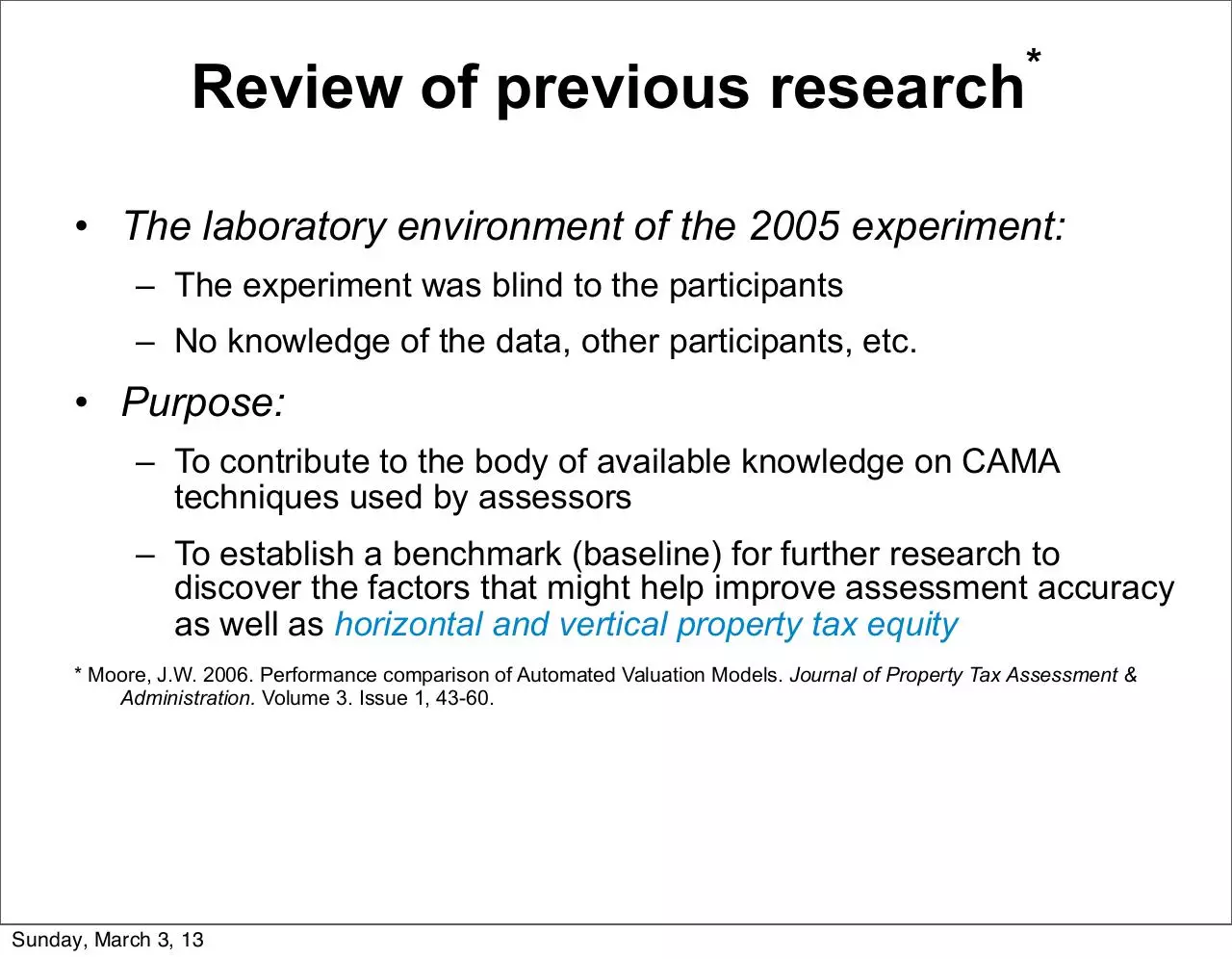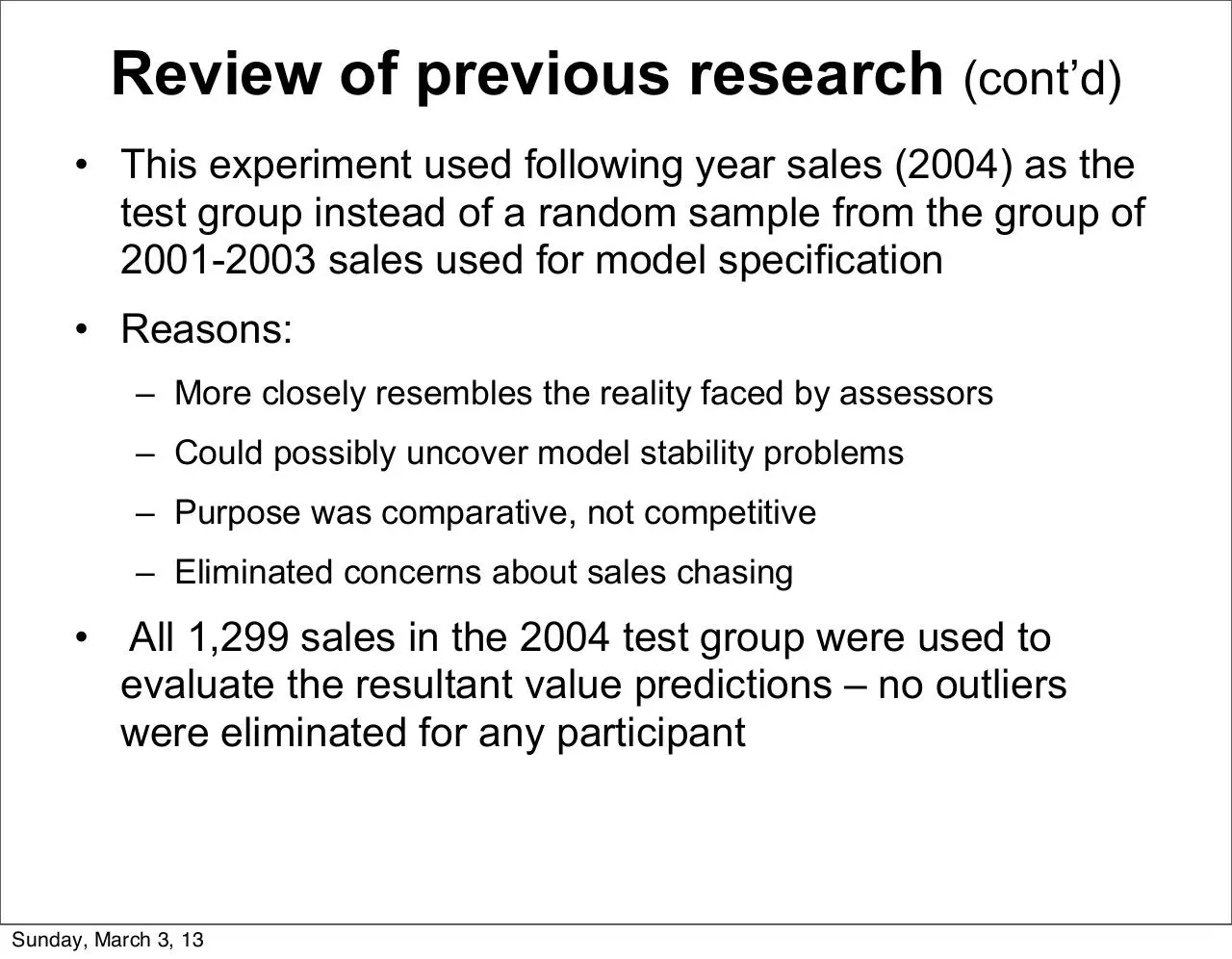IAAO Conference 2010 Presentation (PDF)
File information
Title: Introduction and Statement of Goals
Author: Joshua Myers
This PDF 1.3 document has been generated by Apple Keynote 5.1.1 / Mac OS X 10.8.1 Quartz PDFContext, and has been sent on pdf-archive.com on 03/03/2013 at 09:23, from IP address 70.161.x.x.
The current document download page has been viewed 968 times.
File size: 1.77 MB (33 pages).
Privacy: public file





File preview
Sunday, March 3, 13
Sunday, March 3, 13
Overview
• PART 1 – Wayne Moore
– Review of previous AVM performance research published in 2005/2006
– Review new research that includes location coordinates from GIS and
enhanced methodology for testing horizontal & vertical equity
– Present horizontal & vertical equity test findings
• PART 2 – Joshua Myers
– Describe Geographically Weighted Regression (GWR)
– Describe Geographical-Attribute Weighted Regression (GAWR)
– Explain GWR/GAWR modeling procedure
– Describe the GAWR variable specification and how to practically
interpret the model
Sunday, March 3, 13
*
Review of previous research
• The laboratory environment of the 2005 experiment:
– The experiment was blind to the participants
– No knowledge of the data, other participants, etc.
• Purpose:
– To contribute to the body of available knowledge on CAMA
techniques used by assessors
– To establish a benchmark (baseline) for further research to
discover the factors that might help improve assessment accuracy
as well as horizontal and vertical property tax equity
* Moore, J.W. 2006. Performance comparison of Automated Valuation Models. Journal of Property Tax Assessment &
Administration. Volume 3. Issue 1, 43-60.
Sunday, March 3, 13
Review of previous research (cont’d)
• This experiment used following year sales (2004) as the
test group instead of a random sample from the group of
2001-2003 sales used for model specification
• Reasons:
– More closely resembles the reality faced by assessors
– Could possibly uncover model stability problems
– Purpose was comparative, not competitive
– Eliminated concerns about sales chasing
• All 1,299 sales in the 2004 test group were used to
evaluate the resultant value predictions – no outliers
were eliminated for any participant
Sunday, March 3, 13
Review of previous research
•
(cont’d)
Twelve distinct sets of 1,299 value estimates provided 15,588
observations for sales ratio analysis and comparison of 4 methods:
– Six sets from the MRA and AEP modelers
– Two sets from cost calculations
– Three sets from the TCM participants
– One set from the jurisdiction itself – using TCM
•
All went through exactly the same sales ratio study process
•
Statistics calculated and used for each of the 12 sets of value
estimates were:
– Median A/S ratio
– Price related differential (PRD)
– Coefficient of dispersion (COD)
Sunday, March 3, 13
Review of previous research
Results
Sunday, March 3, 13
(cont’d)
Review of previous research
(cont’d)
Note: The transportable cost-specified market (TCM) AVM is market-calibrated cost
Sunday, March 3, 13
New AVM Research with X-Y Coordinates
• Same data set as used for the 2005 AVM research was used
• Only Lat-Long parcel coordinates were added to the data set
• Test methodology was improved compared to 2005
– Horizontal & vertical equity tested separately
– Random sampling and assignment of 31 COD test groups of 25 parcels each
– Thus, 775 parcels randomly selected from 1299 blind testing sales in 2004
– Quintile groups of 155 sale ratios each created from the same 775 sale sample
• 775 sorted from low to high sale price and divided into five equal groups (quintiles) of 155 each
• Average (mean) of 155 ratios computed for each vertical stratum and labeled Quintile Mean Ratio
– Horizontal equity tested by comparing the mean CODs (MCOD) of the 31 test
groups in each AVM using analysis of variance (ANOVA) hypothesis testing
– Vertical equity tested by comparing the quintile mean ratios (QMRs) of the five
strata - lowest to highest - within each AVM; unequal QMRs when tested with
ANOVA would indicate vertical inequality
– New hypothesis tests were conducted at the alpha = 0.01 level instead of the
alpha = 0.05 level (i.e. for the new testing, p < 0.01; 1 in 100 chance of error)
Sunday, March 3, 13
Significance of the New Research
• Josh Myers’ work has been accomplished under the same
strict experimental controls as the 2005 research.
• As the baseline, Josh Myers’ GAWR/GWR work was blindly
applied to the same test dataset used in the 2005 experiment.
• Josh Myers’ GAWR model performed significantly better than
all other models developed by some of the best modelers in
the country and tested in 2005 using exactly the same data set
and experimental controls, but with no x-y coordinates.
• Josh’s Geographical Attribute Weighted Regression (GAWR)
model incorporates the property x-y coordinates - this research
confirms that location, location, and location are in fact the
three most important characteristics in real estate value.
Sunday, March 3, 13
New AVM Research: Findings - 1
COD - the average absolute deviation of calculated sale ratios from their median expressed as a
percentage of the median (IAAO 1997). Larger COD values indicate diminished uniformity.
PRD - the mean assessment to sale ratio of a sales sample divided by the weighted mean ratio of
the same sample, computed as the total assessed value divided by the total of the sale prices.
VEI - the absolute value of the difference between the highest and lowest of the five QMRs within
a study group divided by the mean of the five QMRs, expressed as a percentage. Larger VEI
values indicate less vertical equity. The VEI was developed by Moore for his 2008 dissertation.
* Jensen, D.L. 2009. The effects of heterogeneous variance on the detection of regressivity and progressivity. Journal of Property
Tax Assessment & Administration. Volume 6. Issue 3, p. 5. Jensen outlined the problems with using PRD as a measure.
Sunday, March 3, 13
New AVM Research: Findings - 2
The ANOVA test statistically confirms that at least one AVM’s mean COD is
different, providing evidence against the null hypothesis that all AVMs produce
the same COD performance. The Tukey-Kramer multiple comparison tests for
all pair-wise differences between the COD means tells the actual differences.
Sunday, March 3, 13
New AVM Research: Findings - 3
The comparative AVM COD test results can be illustrated graphically with a box plot
Sunday, March 3, 13
New AVM Research: Findings - 4
Hypothesis testing for vertical equity was performed using the five groups of 155
ratios in each quintile. A separate analysis was conducted for each AVM test
group. Six of the seven AVMs tested failed the vertical equity test.
Sunday, March 3, 13
New AVM Research: Findings – 5
Vertical Equity ANOVA Test Result Box Plots for TCM & MRA
(Similar box plots exist for AEP, COST, GAWR, GWR, and NoRCN)
Sunday, March 3, 13
New AVM Research: Findings – 6
City of Norfolk dataset findings
Sunday, March 3, 13
New AVM Research: Findings – 7
Fairfax County dataset findings
GAWR was also applied to the Fairfax County, Virginia data from the 2006 initiative
sponsored by the IAAO (Clapp and O’Connor, 2008)*. The sales history dataset was
comprised of 51,190 valid residential sales between January 1967 and December
1991. The prediction hold-out sample was comprised of 5000 valid residential sales
between January 1972 and June 1991. The table below compares the predictive
power of GAWR against the two best practice results and the default OLS (MRA)
result reported by Clapp and O’Connor. The GAWR model produced better results
than any of the alternative models.
Sunday, March 3, 13
New AVM Research: Conclusion
• The original research questions developed were:
– To what extent do measures of equity/accuracy differ among available
methodologies for estimating the market value of single-family homes?
– Does the use of spatial attributes from GIS in the market value estimating model
specification improve the measure of equity/accuracy by a statistically significant
amount?
– Does the addition of attribute weighting improve the measure of equity/accuracy
of the market value estimating model by a statistically significant amount over
standard GWR?
• The research conclusions are:
– Horizontal equity does differ among available AVM methodologies
– Spatial attributes from GIS do improve the COD measures of horizontal equity/
accuracy by a statistically significant amount when incorporated in a
geographical-attribute weighted regression (GAWR) model; however, attribute
weighting does not produce a statistically significant difference over GWR
– Vertical equity improvement is not supported by the evidence and needs to be
the subject of future research
Sunday, March 3, 13
Part 2
Description of Method
Geographically Weighted Regression
Sunday, March 3, 13
GWR Background and Theory
• Standard Multiple Regression (MRA) yields one set of
regression coefficients for the entire study area.
– These coefficients indicate the estimated unit value of each
independent variable.
• GWR runs one separate weighted MRA model for every
subject property.
– Therefore, GWR has a separate set of local regression
coefficients for every subject property.
Sunday, March 3, 13
GWR Background and Theory
•
The basic GWR relationship is as follows, where k is the number of
independent variables, (xi,yi) are the coordinates for the ith subject
property, βh(xi,yi) is the regression coefficient for the hth independent
variable for the ith subject property, Xih is the value of the hth
independent variable for the ith subject property, Yi is the sale price
for the ith subject property, Wi is the weights matrix for the ith subject
property, and εi is the error term for the ith subject property.
Sunday, March 3, 13
GWR Background and Theory
• GWR should be viewed as a series of locally weighted
regressions with weighting done by geographic distance.
– Sale properties that are closer to the subject property have more
influence than those that are farther away.
– These weights are established by a weight function.
– An adaptive bandwidth, the best number of nearest-neighbor
sale properties to include in each sliding neighborhood, is used.
Past a certain distance, all sale properties are given zero weight.
Sunday, March 3, 13
GWR Background and Theory
• The weight function used in this
research is the bi-square function, given
below. Here, dij is the distance between
the ith subject property and the jth sale
property and b is the adaptive
bandwidth.
Image Source: Richard Borst
presentation at the 2009 IAAO
Conference, used with permission.
Sunday, March 3, 13
GWR Background and Theory
• As should be apparent, GWR is fundamentally different
from other methods in how it accounts for location.
– Other methods tend to account for location with neighborhood
adjustments, whereas GWR accounts for location using parcel
centroid coordinates from GIS and sliding neighborhoods.
– These neighborhood adjustments used by other methods create a
boundary value problem where parcels that meet on the boundary
of a two neighborhoods may be given very different adjustments.
Also, other methods usually assume neighborhoods to be
homogenous when often they are not.
• GWR methodology has been applied to housing datasets
from Toronto, Montreal, Sarasota, Fl, Catawba, NC,
Fairfax, Va, and Milwaukee, WI, but, to our knowledge,
hasn’t yet been put into practice inside of an actual
assessor’s office or tested in a controlled experiment.
Sunday, March 3, 13
GAWR
• GWR is weighted according to distance, but GAWR is
weighted according to distance and attribute similarity.
• Say, you have three properties: a subject property, a
smaller sale property two doors down to the left of the
subject property, and an exact replica of the subject
property that sold two doors down to the right. Under
GWR, the smaller property would be given about the
same weight as the replica, but under GAWR the replica
would be given more weight than the smaller property.
• GAWR is an analytic implementation of the sales
comparison method, which is the #1 recommended
method for single-family residential.
Sunday, March 3, 13
GAWR Weight Function
• The general form of the spatial-attribute weight function
for the GAWR model is given below. Here, f(τ) is an
exponential function that changes the weight according
to the difference (τ) between attributes of the ith subject
property, Ai, and its jth neighboring sale property, Aj.
Sunday, March 3, 13
GWR/GAWR Modeling Procedure
• A forward step-wise procedure was employed in the
model building phase using the sales history dataset.
– For the research data, the sales history dataset was the valid
sales from 2001 to 2003. For the Norfolk data, the sales history
dataset was the valid sales from 07/01/2005 to 06/30/2007.
• At each step, leave-one-out cross-validation was used to
determine the COD and the corresponding optimum
bandwidth for each of the possible variable additions.
• In general, the variable that most lowered the COD at
each step was added to the model.
• It is also important to determine the best weight function
and the optimum time period to use in the sales history
dataset.
Sunday, March 3, 13
GWR/GAWR Modeling Procedure
• Taking into account the principle of parsimony, the quality
of the local coefficients, and the quality of the estimates,
the set of variables that yields the lowest cross-validated
COD is chosen and the adaptive bandwidth for the set is
recorded.
• The chosen set of variables and the adaptive bandwidth
are then used to run the prediction of the subject
properties using the sales history dataset.
• R, a statistical software program, was used in the
analysis.
Sunday, March 3, 13
GWR/GAWR Variable Specification
Norfolk Variable Set
Research Variable Set
Intercept
Intercept
RCNLD for Dwelling and Garage
RCN for Dwelling and Garage
Squared Reverse Month of Sale (Time)
Reverse Month of Sale (Time)
Pre-determined Land Market Value as an offset
Pre-determined Land Market Value
RCNLD for Other Improvements as an offset
Total Other Area (sum of attic and basement
area)
Total Garage Area
Total Living Area
Neighborhood Indicator Variable (coded 1 if the
sale property is in the same neighborhood
as the subject property, and 0 otherwise)
Sunday, March 3, 13
The Use of Replacement Cost in GAWR
• This goes against the conventional wisdom.
• While being a poor representation of market value, the
replacement cost acts as a good index of the property’s
attributes and how it compares to nearby properties.
• GAWR becomes much more explainable to taxpayers and
appraisers when replacement cost is used as the primary
variable, because replacement cost is easily understood by
many people.
• This clears the major hurdle for regression-based AVMs of
being able to explain the model to the masses. The
interpretation is now simple: the estimate of property value
is made using an implementation of the sales comparison
method to make adjustments to the replacement cost.
Sunday, March 3, 13
Conclusions and Future Work
• The 2005 research demonstrated that no statistically
significant difference exists between TCM, MRA, & AEP,
but that they are each significantly better than Cost.
• The 2010 research demonstrates that GAWR performs
significantly better than other commonly used appraisal
methods that do not use parcel location X-Y coordinates.
• This new research has shown evidence that if a statistically
significant improvement is desired, parcel centroid
coordinates must be incorporated using a model like
GAWR.
• The Fairfax Dataset results show that not all models that
use parcel X-Y coordinates are created equal. GAWR
performed the best among a host of models that also used
X-Y coordinates.
Sunday, March 3, 13
Conclusions and Future Work
• As demonstrated in Norfolk, GAWR can be applied to local
jurisdictions and is not just some “academic” method.
– The replacement cost is used as one of the main variables in the
GAWR model and makes the model much more explainable to the
masses.
– GAWR can also result in potentially large time-savings over manual
methods.
• Our future plan is to continue to make the GAWR model
better and try to improve vertical equity results.
• This work will be has been accepted for publication in
Property Tax Assessment & Administration, 2010 Q3
Sunday, March 3, 13
Questions
&
Discussion
Sunday, March 3, 13
Download IAAO Conference 2010 Presentation
IAAO Conference 2010 Presentation.pdf (PDF, 1.77 MB)
Download PDF
Share this file on social networks
Link to this page
Permanent link
Use the permanent link to the download page to share your document on Facebook, Twitter, LinkedIn, or directly with a contact by e-Mail, Messenger, Whatsapp, Line..
Short link
Use the short link to share your document on Twitter or by text message (SMS)
HTML Code
Copy the following HTML code to share your document on a Website or Blog
QR Code to this page

This file has been shared publicly by a user of PDF Archive.
Document ID: 0000094489.